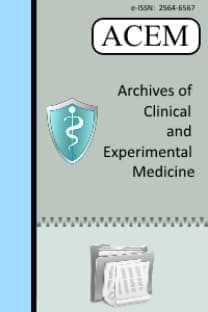Tip 2 diyabetik bireylerde kreatinin klirensini hesaplamada kullanılan üç farklı yöntemin karşılaştırılması
Kreatinin klirensi, glomeruler filtrasyon hızı, tip 2 diyabet
Comparison of three different creatinine clearance calculation methods in patients with type 2 diabetes mellitus
___
- 1. King H, Auert RE, Herman WH. Global burden of diabetes, 1995- 2025:Prevalence, numerical estimates,and projections. Diabetes Care. 1998;219:1414-31.
- 2. Howlett HCS, Bailey CJ. A risk-benefit assessment of metformin in type 2 diabetes mellitus. Drug Saf. 1999;20:489-503.
- 3. Microvascular Complications and Foot Care: Standards of Medical Care in Diabetes—2018. American Diabetes Association. Diabetes Care. 2018; 41:S105-18.
- 4. Satman I, Yilmaz T, Sengül A, Salman S, Salman F, Uygur S et al. Population-based study of diabetes and risk characteristics in Turkey: results of the turkish diabetes epidemiology study (TURDEP). Diabetes Care. 2002;25:1551-6.
- 5. Mogensen CE, Christensen CK, Vittinghus E. The stages in diabetic renal disease. With an emphasis on the stage of incipient diabetic nephropathy. Diabetes. 1983;32:64-78.
- 6. Cockroft DW, Gault MH. Prediction of Creatinine Clearance from serum creatinine Nephron. 1976;16:31-41.
- 7. Levey AS, Bosch JP, Lewis JB, Greene T, Rogers N, Roth D. A More Accurate to Estimate Glomerular Filtration Rate From Serum Creatinine; A New Prediction Equation. Ann Int Med. 1999;130:461-70.
- 8. KDIGO 2012 Clinical Practice Guideline for the Evaluation and Management of Chronic Kidney Disease. Kidney Int Supp. 2013:1-150.
- 9. Willems JM, Vlasveld T, den Elzen WP, Westendorp RG, Rabelink TJ, de Craen AJ et al. Performance of Cockcroft-Gault, MDRD, and CKD-EPI in estimating the prevalence of renal function and predicting survival in the oldest old. BMC Geriatrics. 2013;13:113.
- 10. Teruel JL, Sabater J, Galeano C. The Cockcroft-Gault equation is better than MDRD equation to estimate the glomerular filtration rate in patients with advanced chronic renal failure. Nefrologia. 2007;27:313-9.
- 11. Helou R. Should We Continue to Use the Cockcroft-Gault Formula? Nephron Clin Pract. 2010;116:172–86.
- 12. Tiao JY, Semmens JB, Masarei JR, Lawrence-Brown MM. The effect of age on serum creatinine levels in an aging population: relevance to vascular surgery. Cardiovasc Surg. 2002;10:445-51.
- 13. Michels WM, Grootendorst DC, Verduijn M, Elliott EG, Dekker FW, Krediet RT. Performance of the Cockcroft-Gault, MDRD, and new CKD-EPI formulas in relation to GFR, age, and body size. Clin J Am Soc Nephrol. 2010;5:1003-9.
- 14. Rigalleau V, Lasseur C, Perlemoine C, Barthe N, Raffaitin C, Chauveau P et al. Cockcroft-Gault formula is biased by body weight in diabetic patients with renal impairment. Metabolism. 2006;55:108-12.
- 15. Brown DL, Masselink AJ, Lalla CD. Functional range of creatinine clearance for renal drug dosing: a practical solution to the controversy of which weight to use in the Cockcroft-Gault equation. Ann Pharmacother. 2013;47:1039-44.
- 16. Carter JL, Stevens PE, Irving JE, Lamb EJ. Estimating glomerular filtration rate: comparison of the CKD-EPI and MDRD equations in a large UK cohort with particular emphasis on the effect of age. QJM. 2011;104:839-47.
- ISSN: 2564-6567
- Yayın Aralığı: Yılda 3 Sayı
- Başlangıç: 2016
- Yayıncı: -
Fatih Orkun KUNDAKTEPE, Mustafa Genco ERDEM, Şerife Ayşen HELVACI
Granüler hücreli tümör tanısında Nestin immunhistokimyasının kullanımı
ÖZGÜR HİLAL ERİNANÇ, Hüseyin Savaş GÖKTÜRK, Gülhan Kanat ÜNLER, ERDAL KARAGÜLLE
Sıçanlarda oluşturulan cerrahi müdahalesiz yeni bir deneysel Asherman sendromu modeli
Kist hidatiğin cerrahi tedavisinde rekürrens ile ilişkili faktörler
Ayetullah TEMİZ, GÜRKAN ÖZTÜRK, Abdullah KISAOĞLU, Ercan KORKUT, Erdem KARADENİZ
Nöroblastoma hücrelerinde hesperidinin apoptozu tetiklemesi
Tolga ÇATMAKAŞ, BARIŞ ERTUĞRUL, ELİF SİNEM İPLİK, BEDİA ÇAKMAKOĞLU
Down sendromlu çocuklarda gastrointestinal bulgular: Çölyak hastalığı için erken bir belirti var mı?
YAKUP ALSANCAK, Serkan SİVRİ, Serdal BAŞTUĞ, Engin BOZKURT
Metastatik renal hücreli karsinomun pulmoner ven yoluyla sol atriyuma uzanımı: Bir olgu sunumu
The impact of vitamin D on rheumatoid arthritis: real or just patient’s perception?
Aslı ÇALIŞKAN UÇKUN, Fatma GÜL YURDAKUL, Ayşegül KILIÇARSLAN, Bedriye BAŞKAN, FİLİZ SİVAS, Semra DURAN, HATİCE BODUR
